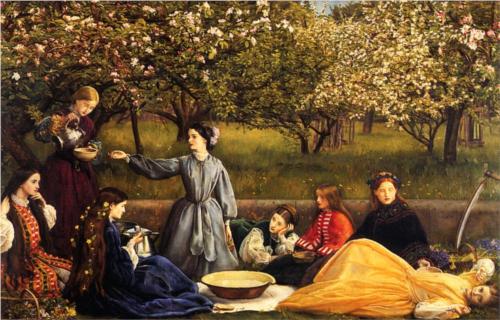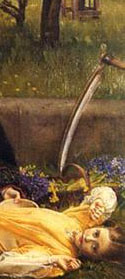
Apple Blossoms captures a relaxing outing on a spring day. Liverpool Museums points out that there are many different ways to interpret this painting, especially with the odd appearance of a scythe on the right hand side of the picture.
On the face of it, this is a picture about youth and beauty, but it has a deeper message. On the right is a scythe, hinting at the inner meaning of the picture. The scythe is a traditional symbol of death, associated with the figure of ‘Death, the Grim Reaper’, often depicted as a skeleton carrying a scythe. Millais’s message is that even the youth and beauty of the girls will come to an end. Flowers fade, the seasons move on and the summer grass is cut down at harvest time. — Liverpool Museums
Turning to The Life and Letters of Sir John Everett Millais (written by his son) I am unable to find any reference to the scythe, but there is a lengthy description of the painting from the artist’s wife Effie:
In May, 1858, they went as usual to Bowerswell, where in due time the artist applied himself to ‘Apple Blossoms’, or ‘Spring’ as it was latterly called, painting it in neighboring orchards.
Here I must again avail myself of my mother’s notebook, and her remarks on ‘Spring Flowers’, as she calls it.
“This picture, whatever its future may be, I consider the most unfortunate of Millais’ pictures. It was begun at Annat Lodge, Perth, in the autumn of 1856, and took nearly four years to complete. The first idea was to be a study of an apple tree in full blossom, and the picture was begun with a lady sitting under the tree, whilst a knight in the background looked from the shade at her. This was to have been named ‘Faint Heart Never Won Fair Ladye’. The idea was, however, abandoned, and Millais, in the following spring, had to leave the tree from which he had made such a careful painting, because the tenant at Annat Lodge would not let him return to paint, for she said if he came to paint in the garden it would disturb her friends walking there. This was ridiculous, but Millais, looking about for some other suitable trees, soon found them in the orchard of our kind neighbor Mrs. Seton (Potterhill), who paid him the greatest attention. Every day she sent her maid with luncheon, and had tablecloths pinned up on the trees so as to form a tent to shade him from the sun, and he painted there in great comfort for three weeks whilst the blossoms lasted. During that year (1857) he began to draw in the figures, and the next year he changed to some other trees in Mr. Gentle’s orchard, next door to our home. Here he painted in quiet comfort, and during the two springs finished all the background and some of the figures. The centre figure was painted from Sir Thomas Moncrieff’s daughter Georgiana (afterwards Lady Dudley); Sophie Gray, my sister, is at the left side of the picture. Alice is there too, in two positions, one resting on her elbow, singularly like, and the other lying on her back with a grass stem in her mouth. He afterwards made an etching of this figure for the Etching Club, and called it ‘A Day in the Country’. When the picture of ‘Spring Flowers’ was on the easel out of doors, and in broad sunlight, the bees used often to settle on the bunches of blossom, thinking them real flowers from which they might make their honey. ” –The Life and Letters of Sir John Everett Millais Vol. I

